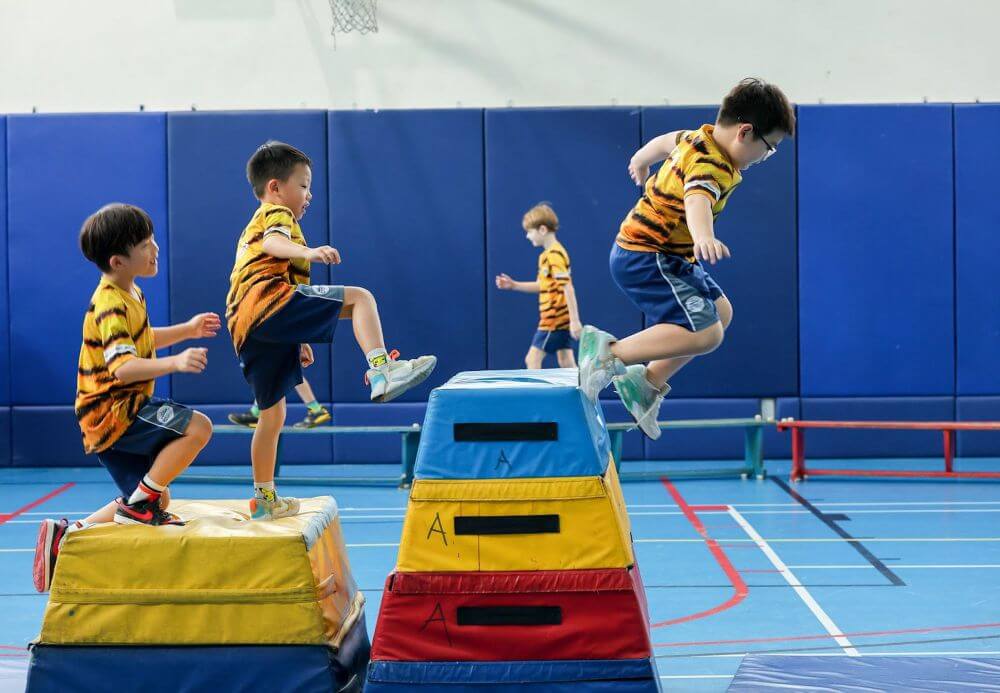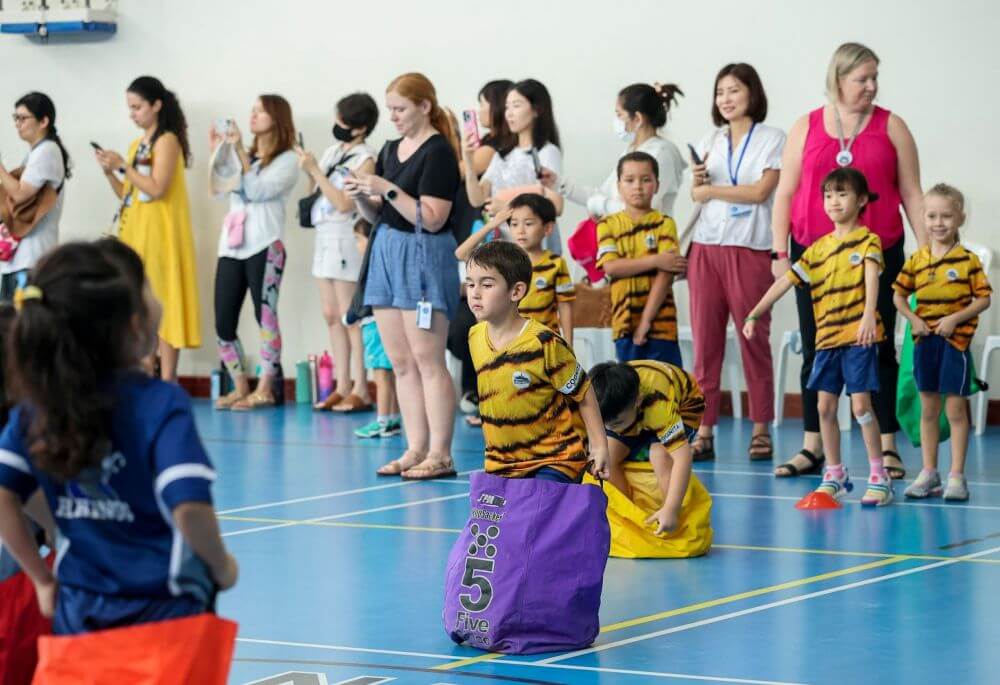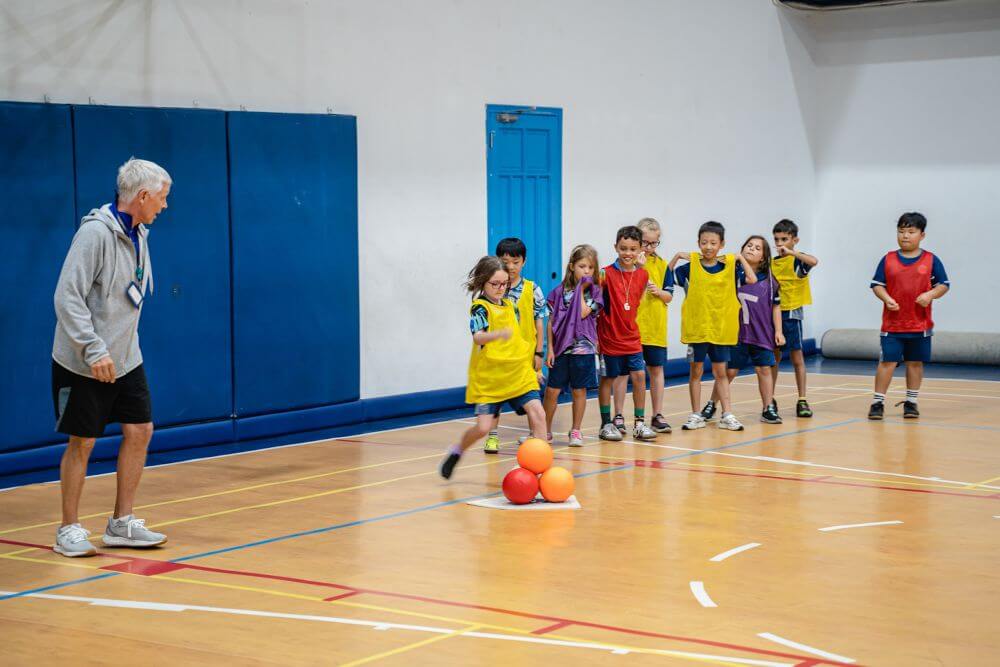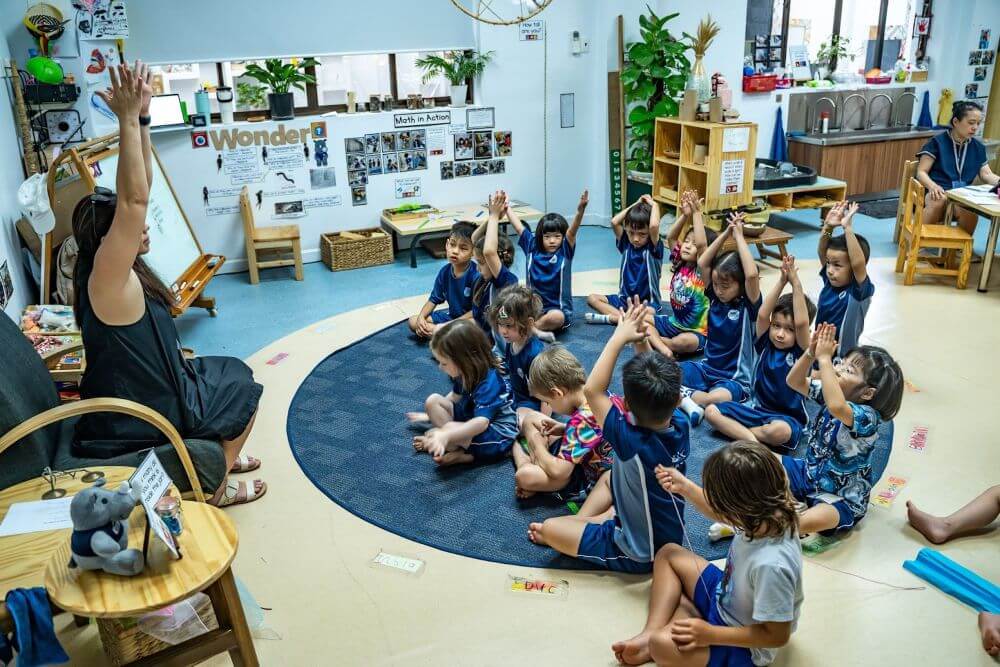Playground Ideas to Improve Skills in Primary School Students
Playgrounds are essential environments for the holistic development of children in primary schools, providing opportunities for physical, cognitive, and social growth. Implementing innovative and well-designed playground ideas for primary schools can significantly enhance these developmental aspects, fostering teamwork, creativity, and problem-solving skills.
This article explores various playground ideas that can be integrated into primary school settings to optimize young students’ learning and developmental experiences. By adopting these ideas, educators and school administrators can create stimulating and safe play environments that support every child’s multifaceted development.
Playground Ideas for Primary Schools: Markings Games
As educators explore new playground ideas for primary schools, implementing markings games proves instrumental in promoting play-based learning.
1. Traditional Hopscotch
Traditional Hopscotch is a classic playground game that requires minimal equipment and offers moderate physical activity. For this game, you need a hopscotch diagram, which can be drawn with chalk, and a small object like a bean bag to use as a marker. The game can be played by one or more participants and involves moderate activity levels, focusing on movement skills such as balance on one foot, jumping, and hopping.
How to play:
- The first player throws a marker into box number 1.
- The player hops on one foot to the end, avoiding the square with the marker.
- At the last box, the player turns, hops back, and picks up the marker from box 1 while balancing on one leg.
- The player then continues, throwing the marker into box 2 and so forth.
- Players take turns, starting from where they left off until someone navigates all the spaces.
- A player forfeits their turn if they fail to throw the marker fully inside the intended box, step on a line, hop into a box with the marker, or use their hands for support.
- The first player to complete the course wins.
2. Hopscotch – Search Around
Hopscotch – Search Around is an engaging variation of traditional hopscotch, requiring more complex equipment and teamwork. For this game, you need 3 hopscotch diagrams and 3 baskets containing 10 different items, such as bean bags, small balls, rings, and sticks. This game suits two or more participants and involves moderate activity levels, emphasizing balance on one foot, jumping, and hopping.
How to play:
- Divide the players into small teams, each with its hopscotch area.
- Assign an additional pupil as a ‘caller’ who lists numbers 1 to 10 with corresponding items.
- Place the baskets a set distance from each hopscotch area.
- Teams start on number 1. The caller announces the first item to be collected.
- Teams collect and place the item on number 1, then ask for the next item.
- Continue until each square contains an item. The first team to collect all ten items wins.
- Progressions include the caller announcing specific actions like hopping on one leg.
3. Hopscotch – Statues
Hopscotch – Statues is another creative twist on traditional hopscotch, combining balance and reaction time elements. This game requires a hopscotch diagram, chalk, and small objects like bean bags or number cards. It is suitable for two or more participants, offering moderate physical activity and focusing on balance on one foot, jumping, and hopping.
How to play:
- Divide players into two or three teams, each with its hopscotch area.
- An additional pupil acts as the caller.
- Teams start at number 1 and play regular hopscotch.
- When the caller shouts “statues,” players must freeze until “hopscotch” is called again.
- If a player moves, they start over. The first team to finish wins.
- Progressions include the caller drawing a number card and players placing the bean bag on the corresponding number.
4. Activity Circuit
Activity Circuit is a versatile playground that promotes various movement skills through an obstacle course. The required equipment includes activity circuit markings, a ball, hoops, and cones. This game can be played by one or more participants and involves moderate activity levels, focusing on balance, jumping, hopping, skipping, and running.
How to play:
- Children follow a trail of instructions around the circuit, such as:
- Stepping Stones: Move from one step to the next on tiptoes or jumping with both feet.
- Jumping Lines: Jump as far as possible to the baseline.
- Balance Beam: Walk along a beam with one foot in front of the other.
- Squiggly Line: Run along the line as quickly as possible.
- Frog Prints: Jump with both feet along the prints or hop on one foot.
- Skip/Foot Prints: Skip along the prints.
- Slalom: Jump alternately from side to side.
- Progressions include walking backward on the beam, hopping on one foot, and adding obstacles.
5. Compass Relay
Compass Relay is an engaging team activity that combines running with navigational skills. The game requires chalk, a non-slip mat, a watch, and a ball. It is suitable for four or more participants, involving moderate physical activity and focusing on running, turning, and progressions like hand dribbling, skipping, and hopping.
How to play:
- Mark all eight compass points on the ground.
- Each player starts outside one of the outer points.
- One player runs to the center, then out to each point, returning to the center each time.
- Other players time the run or count the duration. The fastest player wins.
- Progressions include bouncing a ball, skipping, or hopping instead of running.

6. Compass Tig
Compass Tig is a dynamic game that incorporates quick movements and strategic dodging. All equipment is optional for this game, which can accommodate six or more participants. The activity level is moderate, focusing on running, turning, and dodging.
How to play:
- One child is the ‘navigator’ and stands in the center of the compass.
- The navigator calls out different compass points.
- Other players run to the specified point without being caught by the navigator.
- The navigator can move from the center to catch players once a point is called.
- When a player is caught, they become the new navigator.
- Progressions include playing games like Clock Tig, where players swap places upon hearing their compass points called.
7. Compass Ball
Compass Ball is a low-activity game that emphasizes coordination and teamwork. Required equipment includes 8-10 beanbags or small balls. Ideally, the game involves nine participants, with each player standing on a compass point. The activity level is low, focusing on throwing and catching skills.
How to play:
- Players stand on compass points. One player on an outer point starts with a ball or beanbag.
- Outer players remain still, while inner players move clockwise.
- The ball is thrown to the inner points, caught, and returned to the outer players.
- Players change positions if the ball is dropped.
- Progressions include using more balls or rotating outer players.
8. Collect the Treasure
Collect the Treasure is an interactive game that promotes trust and communication among participants. The needed equipment includes objects like bean bags or rings that act as treasures. The game is suitable for two or more participants, and its moderate activity level focuses on balance, walking, and turning.
How to play:
- Place an item in the center of a maze to represent the treasure.
- Players pair up, with one blindfolded or closing their eyes.
- The blindfolded player navigates the maze based on verbal commands from their partner, who stands outside the maze.
- The goal is to guide the blindfolded player to the treasure and back.
- Players swap roles and repeat the game.
- Progressions include adding obstacles to the maze for more challenging navigation.

Playground Ideas for Primary Schools: Skipping and Elastics Games
Integrating skipping and elastic games into innovative playground ideas for primary schools revitalizes traditional play experiences with modern educational benefits.
9. Skipping Games
Skipping games are lively and engaging playground activities that promote physical fitness and coordination among children. The necessary equipment includes a long rope, typically 14 feet in length. The game requires a minimum of three participants, with two serving as rope turners. Skipping games involve moderate activity levels and focus on movement skills such as skipping and jumping. These games enhance physical skills and encourage teamwork and social interaction.
Types of Skipping Games:
- Under the Moon:
- Turners rotate the rope towards the skipper.
- The skipper runs under the rope as it brushes the floor and moves up.
- Skippers continue running in a figure of eight around the turners.
- Over the Stars:
- Turners rotate the rope away from the skipper.
- The skipper jumps over the rope as it clips the floor and moves towards them.
- Under the Moon & Over the Stars:
- Skippers combine running under and jumping over the rope.
- They run in a figure of eight, entering and exiting from both sides.
- Follow the Leader:
- A leader performs a move in the rope, followed by four or five pupils repeating the move.
- Postman:
- A pupil skips while singing a tune and performing actions such as jumping and exiting the rope.
- Girl Guide:
- A pupil skips while singing a tune and doing actions like saluting, bowing, and twisting.
- Criss-cross:
- Skippers are divided into two groups.
- Groups enter and exit the rope alternately, running in a figure of eight.
- Simplified versions allow more jumps before exiting the rope.
10. Elastics Games
Elastics games are another excellent playground activity that fosters agility and coordination. You need French elastics or a long piece of elastic tied together for these games. Three or more participants are required, with two players holding the elastic and one jumping. The activity level is moderate, focusing on jumping and hopping skills.
How to play:
- Setup:
- Two players hold the elastic, facing each other, about 5 feet apart.
- The elastic is placed around their legs, halfway between the ankle and knee.
- Gameplay:
- The jumper performs specific movements and foot positions with the elastic.
- Movements change with each syllable of a chant.
- Variations can include different jumping patterns and heights for the elastic.

Playground Ideas for Primary Schools: Catching Games
When exploring playground ideas for primary schools, catching games provide an entertaining outlet for children to improve their coordination and collaboration skills.
11. Prison Wall
Prison Wall is an active and engaging playground game that requires no equipment. It accommodates a large group of eight or more participants, making it ideal for schoolyard settings. This game involves moderate activity levels and focuses on movement skills such as running and dodging.
How to play:
- Approximately a meter apart, two parallel lines are drawn across the designated area, creating the “Prison Wall.”
- One or two players stand between these lines and act as the catchers who cannot venture beyond these boundaries.
- The other players attempt to run across the area without being touched by the catchers.
- If a player is tagged by a catcher, they must join the catchers between the lines.
- The game continues until all players are caught or until a predetermined time limit is reached.
12. Sharks and Barracudas
Sharks and Barracudas is a dynamic and strategic game requiring no equipment, making it ideal for a large group of twelve or more participants. It promotes moderate physical activity, focusing on running and dodging skills.
How to play:
- Divide the participants into two groups: Sharks and Barracudas.
- Set up two lines of cones at opposite ends of the playing area to serve as safe zones for each group.
- Designate a leader among the Sharks who faces the Barracudas while the rest face away from them.
- The Barracudas start walking towards the Sharks. When they are close enough, the leader shouts, “Barracudas!”
- Upon hearing the shout, the Sharks turn around and attempt to tag the Barracudas before they reach their safe zone.
- If a Barracuda is tagged by a Shark, they become a Shark and join in tagging the remaining Barracuda.
- Ensure the playing area is free from obstacles and the lines are placed away from walls to prevent collisions.
13. Man from Mars
Man from Mars is an imaginative and active playground game requiring no equipment. It is suitable for groups of eight or more participants and involves moderate activity levels, focusing on running and dodging.
How to play:
- Select one player to be the “Man from Mars,” who stands in the middle of the playing area facing the other participants, known as the “earthlings.”
- The game begins with the earthlings chanting: “Man from Mars, Man from Mars. Will you take us to the stars?”
- The Man from Mars replies with a color (e.g., “Only if you are wearing blue!”).
- Earthlings wearing the specified color can safely walk to the other side of the playing area, while those without that color must run to avoid being tagged by the Man from Mars.
- Tagged earthlings join the Man from Mars in the center and help tag others in subsequent rounds.
- The game continues with different colors being called out and players trying to avoid being caught.
14. Little Brown Bear
Little Brown Bear is an active and creative playground game that requires no equipment and is suitable for groups of eight or more participants. It promotes moderate physical activity and focuses on running and dodging skills.
How to play:
- Select one player to start as the “Little Brown Bear,” who stands in the middle of the playing area.
- The other players line up on a sideline facing the Little Brown Bear.
- The game begins when the Little Brown Bear says, “Who’s afraid of the Little Brown Bear?”
- The players respond, “Not I.”
- The Little Brown Bear then instructs the players to move across to the opposite sideline (e.g., “Then I want you to skip to the other side!”).
- Players must perform the instructed movement (e.g., skipping) while the Little Brown Bear tries to tag them.
- Tagged players become helpers and join the Little Brown Bear in the middle, assisting in tagging other players.
- The game continues until all players have been caught, with the Little Brown Bear calling out different ways to move each time to keep the game engaging and varied.

Playground Ideas for Primary Schools: Relay Games
Relay games promote teamwork, coordination, and physical activity among primary school children. These playground ideas for primary schools often involve passing objects or completing tasks sequentially, encouraging competitiveness and cooperation.
15. Gear Gather Relay
Transitioning from individual games to team-oriented activities, Gear Gather Relay is a lively game requiring equipment bundles and fostering teamwork among participants. This game suits large groups with twelve or more players and involves a moderate activity level, primarily focusing on running.
How to play:
- Prepare multiple equipment bundles, each containing the same type and number of items (e.g., ball, bib, shuttlecock).
- Divide the participants into teams, ensuring each team lines up behind the starting line facing their designated equipment bundle.
- On the start signal, the first player from each team runs to the equipment bundle, collects one piece of equipment, and returns to tag the next player.
- The second player then runs to the bundle, picks up another piece of equipment, and continues this pattern.
- Each subsequent player adds another piece of equipment until the last player returns with all the pieces from the bundle.
- The team that completes the relay and gathers all equipment first wins the game.

16. Circle Pass Relay
Circle Pass Relay is a collaborative game requiring a ball per team and is suitable for groups of twelve or more. It enhances moderate activity levels and emphasizes throwing and catching skills.
How to play:
- Divide the players into small teams of 4-5 individuals per team.
- Each team forms a circle with players facing outward and standing approximately 1 meter apart.
- Provide each team with a ball.
- The first player in each team starts by passing the ball to the next player in the circle.
- Once the ball reaches the last player in the circle, that player runs around the outside and returns to their position.
- The ball continues to be passed around the circle similarly until all players have run around the circle.
- Progressions can include combining small teams into larger groups and introducing additional balls to increase complexity.
- For an added challenge, the last players from each team can race around the circle, with the fastest player securing their team’s victory.

17. Corner Relay
Corner Relay is an engaging game that utilizes cones to create a course. It is suitable for promoting various movement skills and agility among participants. It is designed for groups of eight or more players and involves moderate activity levels.
How to play:
- Set up cones in a square formation, with four corners marked out.
- Divide the participants into two teams of equal numbers, lining them up behind diagonal corners of the square.
- On the command “go”, the first player from each team runs anti-clockwise around the four corners of the square course.
- Upon returning to their starting corner, the player tags the next teammate in line to continue the relay.
- The team that completes the course with all members running around the corners first wins the game.
- Progressions can involve varying the movement skills required:
- Players can hop, skip, or jump around the course.
- Introduce tasks like dribbling a ball or skipping with a rope while completing the course.
- Increase difficulty by incorporating multiple tasks simultaneously or adding obstacles to maneuver around.

19. Wall Ball
Wall Ball involves a ball and bibs. It is suitable for groups of eight or more participants and focuses on moderate activity levels and enhancing throwing and catching skills.
How to play:
- Divide the group into two teams of similar ability levels, assigning bibs if needed for team distinction.
- Begin the game by giving possession of the ball to one team.
- The objective is for the team in possession to pass the ball among themselves while attempting to touch the designated end wall with the ball.
- Successfully touching the wall scores a point for the team.
- After scoring or a possession change, the opposing team takes control of the ball and strives to touch the opposite wall for a point.
- Ensure the game remains non-contact to maintain safety and fair play throughout.
20. Target Ball
Target Ball requires a ball, bibs, and a designated target area, accommodating groups of eight or more participants. It promotes moderate activity levels and enhances throwing, catching, and aiming skills.
How to play:
- Divide the participants into teams and define a playing area, optionally assigning colored bibs for team identification.
- Start by giving possession of the ball to one team, whose objective is to pass and maintain possession while aiming to score by throwing the ball into the “catch target ring”.
- Players must pass the ball quickly as they cannot move with it.
- Each successful basket scored into the target ring earns the team a point.
- Possession changes if the ball is dropped, intercepted by opponents, or leaves the designated playing area.
- Encourage strategic play and teamwork as teams compete to achieve the highest score within the game’s timeframe.

Enhance Students’ Creativity with Playground Activities at ISHCMC
At ISHCMC, we prioritize nurturing creativity and holistic development through diverse playground ideas for primary schools. Our facilities include an adventure playground, a 25m 6-lane pool, and outdoor courts, providing ample space for students to play, explore, and develop essential physical and social skills.

Discover how ISHCMC empowers students through dynamic playground activities and state-of-the-art facilities. Contact us today to schedule a tour and learn more about our comprehensive educational offerings. Join us at ISHCMC, where every child discovers the joy of learning and growing through play!
FAQs
When exploring playground ideas for primary schools, parents should consider various factors to ensure a safe and enjoyable experience for all children.

1. What should you consider before selecting a playground idea?
Before selecting a playground idea, it’s crucial to take into account several key factors:
- Players’ age and gender: Consider the age range and gender diversity of the children using the playground. Different age groups may have varying physical abilities and interests.
- Level of skill: Evaluate the skill level of the players participating in the activities. Ensure that the playground idea aligns with their abilities to keep them engaged and challenged appropriately.
- Experience: Consider the players’ prior experience with similar activities or games, which can influence the complexity and rules of the playground idea chosen.
- Level of ability: Assess the children’s physical and cognitive abilities, including special needs. Ensure that the playground idea is inclusive and accessible to all participants.
- Children with special needs: Design or select playground ideas that accommodate children with special needs, providing adaptations or alternative activities as necessary.
- Equipment available: Determine the availability and suitability of equipment required for the chosen playground idea. Ensure it is safe, well-maintained, and appropriate for the intended use.
- Space available: Consider the size and layout of the playground area. Ensure the selected idea fits within the available space without overcrowding or safety hazards.
- Number of players: Plan the activities based on the expected number of participants. Some ideas may require specific numbers to work effectively or may need modifications for smaller or larger groups.
Careful consideration of these factors ensures that the chosen playground promotes inclusivity, safety, and enjoyment for all children involved.
2. What are tips to ensure safety for kids when playing games?
Ensuring safety during playtime is essential to promote continuous engagement and minimize risks. Here are vital tips to uphold safety guidelines:
- Space adequacy: Ensure the playing area is spacious enough for the intended activities. For example, ensure basketball courts have adequate space beyond the out-of-bounds lines to prevent collisions with walls.
- Surface suitability: Inspect playing surfaces regularly to ensure they are smooth and free from hazards like bumps or holes, especially on fields used for activities like soccer.
- Equipment maintenance: Regularly maintain playground equipment and promptly remove any faulty items from use – report equipment issues promptly to school authorities.
- Clear instructions: Before starting activities, clearly explain the rules and safety guidelines to all participants and emphasize safe play practices throughout.
- Progressive learning: Introduce new activities gradually, starting at a basic level and progressing as participants become more familiar and skilled.
- Appropriate equipment use: Ensure children use equipment only for its intended purpose. Supervise to prevent misuse that could lead to accidents, such as improper use of skipping ropes.
- Active supervision: Maintain constant awareness of children’s activities. Stop any game or activity immediately if it poses a safety risk or could lead to accidents.
- Appropriate attire: Ensure children wear suitable clothing for the activity to prevent accidents, such as avoiding loose clothing on climbing equipment.
- Equal access: Implement a rotation system for popular areas to ensure fair access and opportunity for all children to participate safely.
By implementing these safety tips, schools can create a secure environment where children can confidently and safely engage in physical activities.
3. What are ideas to help children adapt to the activities better?
Ensuring that all children can participate fully in playground activities requires thoughtful adaptation strategies. Here are practical ideas to support children’s adaptation:
- Clear demonstrations: Provide visual demonstrations of activities to ensure understanding and encourage participation.
- Adapted movement for wheelchair users: Enable wheelchair users to participate by adapting movements such as zigzagging, using both arms simultaneously, or turning in circles.
- Buddy system: Pair children to work together, alternating tasks like picking up and placing objects, fostering collaboration and support.
- Adjusting object heights: Place objects at varying heights to accommodate different abilities, using chairs or boxes for easier access.
- Visual aids for the hearing impaired: Use flashcards or visual cues to help hearing-impaired children understand instructions or cues.
- Spatial adjustments: Increase space between markers or use tactile trails to assist visually impaired children in navigating the play area.
- Adaptive equipment: Provide bean bags or koosh balls to aid children in balancing or use slower-moving balls or balloons to allow more reaction time.
- Lighter throwing objects: Lighter objects, like koosh balls, make throwing activities easier for children.
- Modified rules: Adapt game rules to suit different abilities, ensuring all children can engage meaningfully.
- Inclusive practices: Create inclusive practices that allow all children time for repetition and success, fostering confidence and participation.














